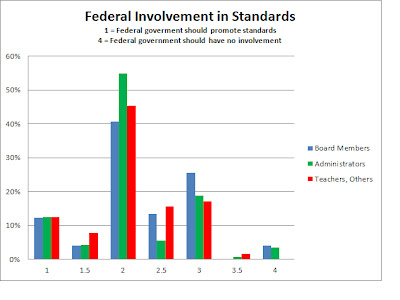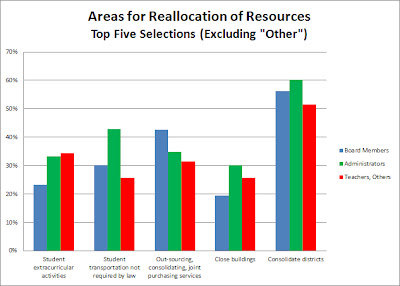This discussion was prompted by controversial legislation introduced at the beginning of the 2013 session. A bill requested by the House Commerce Committee in January would have removed teacher evaluation procedures and teacher assignments for class periods (such as when a district changes daily class scheduling) from the list of items boards must negotiate in districts where teachers have voted to collectively bargain. (This includes vast majority of school districts in Kansas). The bill would also have made the entire bargaining process itself optional for local school boards.
In testifying on the bill, KASB - as always - looked to the policy positions adopted by its Delegate Assembly. In the "First in Education, the Kansas Way" resolution adopted last December, delegates from KASB member boards made removal of teacher evaluation procedures from mandatory collective bargaining a priority issue. Basically, KASB members were concerned that boards will have to "give up something " in the bargaining process simply to comply with new state evaluation standards under development by the State Board of Education. However, the position adopted by delegates also supported the current requirement that employees being evaluated have input on the evaluation system, provided it’s done OUTSIDE of the collective bargaining process. Therefore, KASB testified in support of that portion of the bill.
KASB also testified it has a long-standing policy position supporting a much shorter list of topics required to be negotiated than under the current professional negotiations act. This position dates back many decades and has not been discussed for many years, but it has never been changed by the Delegate Assembly. KASB also testified that this position, in effect, supports a list items which SHOULD be negotiated. Therefore, KASB opposed making negotiations optional for school boards. As later confirmed by a special meeting of the KASB board of directors, KASB's position is to support continuing to require that boards negotiate with teachers (if requested by teachers under the PNA), but to reduce the number of topics that must be negotiated. (Boards and teachers could still agree to add topics to this list, but only if both parties agree.)
Following a hearing on the first bill, Commerce Committee Chair Marvin Kleeb, R-Overland Park, invited interested parties to recommend changes to the PNA that would improve the process. At the same time, the results of a Kansas Association of School Superintendents' member survey indicated most administrators would favor a significantly shorter list of mandatory items for negotiations. KASB staff then worked to develop a new bill to reflect KASB's current positions. That bill, like the original committee proposal, drew strong opposition from the Kansas National Education Association, which opposed any change in current law. Ultimately, rather than bringing the bill to a vote on the House floor, the various organizations agreed to Chairman Kleeb's suggestion that the bill be carried over to the 2014 session, and efforts be made during the interim before the next session to find a position that would draw the most support.
With this background, KASB asked participants at the June 2013 meetings to think about this issue in two ways, and then essentially "graph" their position as follows. First, participants were asked to consider a horizontal line representing change in the professional negotiations act. With current law at the mid-point, each individual was to place a mark representing whether the law should be changed to give teachers more input on the left side, or more board authority on the right. The further from the center, the more significant the change.
Next, participants were asked to consider a vertical line where the top represented a high priority for change, meaning that it should be strongly pushed regardless of controversy. The bottom presented a low priority, indicating that any change was not worth the controversy. KASB staff stressed that any change in the bargaining law would be strongly opposed by KNEA, and very likely most local teacher associations; and that change would only occur if local board members and administrators publicly supported this change with Legislators and others.
To make this point, participants were asked to not only find the "intersection" of their marks on the horizontal and vertical lines, but to also publicly place a colored "dot" on a sheet of paper to illustrate how they felt about both the degree of change supported and the priority it should receive. KASB staff then compiled a master list from the charts produced at each meeting.
A couple of points should be noted. First, not everyone voted with a "dot" - the total is less than the total attendance at the meetings. Second, participants self-identified as to whether they were board members, administrators, teachers or "others" (a group which includes community members, Legislators and State Board members).
A couple of points should be noted. First, not everyone voted with a "dot" - the total is less than the total attendance at the meetings. Second, participants self-identified as to whether they were board members, administrators, teachers or "others" (a group which includes community members, Legislators and State Board members).
Of the 160 school board members who placed dots, 52% were in the upper right quadrant, indicating support for change to give boards more authority AND a high priority for change. Thirty-five percent were in the lower right quadrant, supporting change toward board authority, but as a low priority. Four percent were in the upper left quadrant, supporting change toward teacher input as a high priority, and none were in the quadrant supporting more teacher input as a low priority. Finally, 7% placed dots either at the exact center or on one of the lines, giving no indication of support for change or priority.
These results indicate that a majority of board members who responded favor changes in the bargaining law to increase board authority as a relatively high priority. However, it is less clear how much change is supported. KASB staff further divided the chart into three sections on either side of each line. Forty-one percent of board members were grouped in one section to the right of the vertical line, indicating support for relatively little change, and 37% were in the second section to the right, indicating support for "moderate" change. Only 9% of board members were in the far right section, supporting the most significant change.
Administrators also favored changes in the law to provide more board authority, but at a somewhat lower priority than board members. Forty-five percent of the 138 administrators were in the upper right quadrant (change toward boards/high priority) and 43% were in the lower right quadrant (change toward boards/low priority). Three percent were in the lower left quadrant (change toward teachers/low priority) and 1% were in the upper left (change toward teachers/high priority). Six percent were on the center or on a line.
Among administrators, 41% were in the first section to the right of center, supporting relatively modest change in the law; 37% were in the next section, supporting moderate change, and 10% in the third section to right, supporting more significant change.
KASB welcomed teachers to attend the meetings, and the 37 who responded to this survey were much more evenly split among the various quadrants. Only one respondent (3%) was in the upper right quadrant (more board authority/high priority), but 22% were in the lower right (more board authority/low priority). Thirty-two percent of teachers favored more teacher input, but as a low priority, and 20% favored more teacher input as a high priority. Twenty-two percent of teachers were in the center or on a line, which means over 75% of teacher attending saw changing current law as a low priority, or expressed support for no change or did not indicate a priority.
 Finally, 28 other individuals not identifying with the first three groups attended. This group also evenly split, with 22% favoring change toward boards as a high priority; 15% change toward boards as a low priority; 23% change toward teachers as a low priority; and 18% change toward teachers as a higher priority. Twenty-six percent of this group was on the center or on the lines.
Finally, 28 other individuals not identifying with the first three groups attended. This group also evenly split, with 22% favoring change toward boards as a high priority; 15% change toward boards as a low priority; 23% change toward teachers as a low priority; and 18% change toward teachers as a higher priority. Twenty-six percent of this group was on the center or on the lines.
KASB's Legislative Committee began reviewing this data at its first meeting of the year on July 13. The committee will have to decide whether to recommend changing KASB's position on collective bargaining, and whether to make seeking any change in the law a priority issue for the 2014 Legislative session.
This issue will be discussed at the KASB fall regional meetings, beginning September 24. KASB also expects to be involved in discussions about this issue with teacher and administrator organizations facilitated by Chairman Kleeb.
This issue will be discussed at the KASB fall regional meetings, beginning September 24. KASB also expects to be involved in discussions about this issue with teacher and administrator organizations facilitated by Chairman Kleeb.










.bmp)
.bmp)

